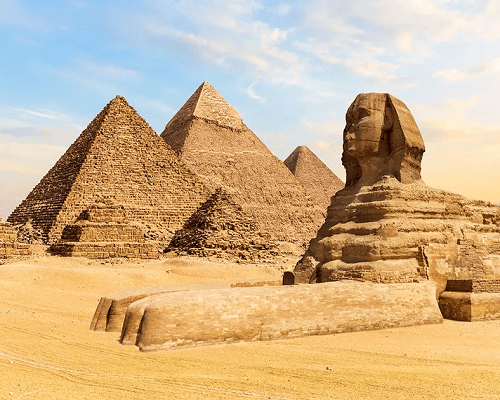- Home
- Egypt Blogger
- Egypt Tours and sightseeing blog
- Giza Pyramids & The Great pyramid

- On 22 Jan 2023
- In Egypt Tours and sightseeing blog
- Tags Giza Pyramids & The Great pyramid
Giza Pyramids & The Great pyramid
Giza pyramids:
Egyptian people call them Ahram, or Ahramat, and they call the great pyramid of Khufu, Al Haram Al Akbar
The great pyramids of Giza are a must see Ancient Egyptian landmark, located just outside the outskirts of Cairo on the esplanade known as Gizeha Plateau. The largest pyramid in the complex is known as Khufu\'s pyramid: an incredible view. It is the only one still standing to-day being one of the seven wonders of the ancient world. There is no way to escape the feeling of being squalor by looking at this colossal structure.
In Giza the two pyramids of Khafre and Menkaure are smaller - but still enormous. Just a couple of steps east you will see three piles of rumbles (20 m high): the queen\'s pyramids tombs of the wives and sisters of Khufu. The Great Sphinx and Solar Boat Museum can be found nearby, on the Giza Plateau. The site also hosts the Giza Sound & Light Show and the Giza camel rides will be held for every newcomer to Egypt.
Egyptian pyramids:
Khufu, Khafre and Menkaure are the designations of the pyramids, which match the Kings they were built for. Khufu, the second king of the 4th dynasty, was the northernmost and oldest pyramid in the group. The largest of three called the Great Pyramid, with a lift of 755, 75 feet at the base on each side and an original height of 481, 4 feet at the base (147 meters). For Khafre, the fourth of the eight kings of the 4th dynasty, the middle pyramid had been built. On each side of that structure it was 707.75 feet (216 feet) long. The original structure was 471 feet (143 meters) high. Menkaure\'s southernmost and final pyramid was built. The fifth king of the fourth dynasty measures 356.5% (109 meters) on each side and the height of the structure is 218 meters (66 meters). In the ancient and mediaeval era, all three pyramids were looted internally and externally. So there are no severe products that were originally deposited in funerary chambers and, since their exterior boxes were almost completely removed from smooth white limestone, the pyramids no longer reach their original height; for example the Grand Pyramid now only has a height of 451.4 feet (138 meters). The outer limestone case of Khafre only reserves in its highest part. A mortuary temple was constructed near every pyramid and connected through a sloping causeway to the Nile Rim valley temple. Subsidiary pyramids were also located nearby used to bury other royal family members.
The great pyramids of Giza:
For almost 4000 years the extraordinary form of Giza pyramids and their magnitude have invited the clear questions of \'What we have been building, and why? The last remaining marvel of the old world has invited. Hundreds of years of research gave us some answers. The workers were built by teams of thousands of workers, built as massive tombs on the orders of the pharaohs. Today they are a terrific tribute to the power of ancient Egypt, organization, and achievements.
On the north side, at about 59 feet above ground level, is the entrance to the Great Pyramid. A sloping Corridor goes down the pyramid through the interior masonry and penetrates the rocky ground on which the structure rests. The uphill passage branches out from the downhill corridor into a room known as the Queen Chamber and into a large, sloping 151 feet (46 m) long gallery. At the top of the gallery, the access to the funeral room is a long and narrow pass, usually called the King\'s Chamber. This room is completely lined with granite topped. Two narrow shafts run oblique from the chamber into the exterior of the pyramid; whether they were designed for a religious purpose or intended to be ventilated is not well known. Five compartments separated by massive horizontal granite slabs above the King\'s Chamber were probably intended to protect and protect the ceiling of the tomb chamber by diverting the immense impetus of the overlying masonry mass.
The amazingness of the Egyptian Pyramids:
There has never been a completely satisfactory answer to the question of how the Egyptian pyramids were built. One of the most reasonable things of all is the fact that with the pyramid of roses, the Egyptians used sloping and round buckthorn with bricks, earth and sand; Stone blocks were transported down the slope using skis, pulleys, and jacks. The Great Pyramid took 20 years to build and required 100,000 men, according to the ancient Greek historian Herodotus. Given these men, this figure is believable, only (or primarily) farmworkers were working on the pyramids while the fields had little work to do - that is when the Nile was underwater. However, archaeologists had found evidence by the end of the 20th century that a limited workforce occupied the site permanently rather than in season. Only 20,000 employees, accompanied by employees (bakers, doctors, clerics, etc.) have been suggested to be suitable for this task.
Conclusion:-
From thousands of years to now, the great pyramids of Giza are still one of the wonders that have not been fully discovered, and what has been discovered is a miracle in itself.
For more info
· Website
· http://www.worldtouradvice.com
· Mobile and what’s App:
· 002 01090023837
